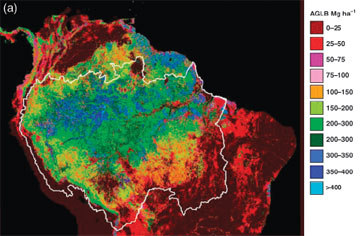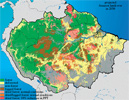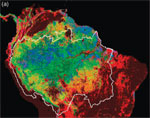|
|
Warming climate could decimate up to 85 percent of the Amazon rainforest by 2150, according to a new computer model.
The study, to be published in Nature Geoscience by researchers from the UK Met Office’s Hadley Centre, found that even a 1-degree rise in global temperatures would cause the “irreversible” loss of large tracts of forest. A larger increase could be “devastating” — 75 percent for a 3-°C-rise and 85 percent for a 4-°C-rise.
“A temperature rise of anything over 1°C commits you to some future loss of Amazon forest. Even the commonly quoted 2°C target already commits us to 20-40 percent loss,” said lead author Chris Jones, speaking at a climate conference in Copenhagen. “On any kind of pragmatic timescale, I think we should see loss of the Amazon forest as irreversible.”

Aboveground live biomass (AGLB) class map of terra firme old growth forests derived from the decision rule classifier and multiple layers of remote sensing data. © Saatchi el al 2007 |
“The impacts of climate change on the Amazon are much worse than we thought. As temperatures rise quickly over the coming century the damage to the forest won’t be obvious straight away, but we could be storing up trouble for the future,” added Vicky Pope of the Hadley Centre, according to The Guardian.
Large-scale Amazon die-off would further worsen warming through massive greenhouse gas emissions, effectively transforming Earth’s largest rainforest from a sink to a source of carbon emissions. Trees and vegetation in the Amazon are estimated to store 90-140 billion tons of carbon and have been absorbing CO2 at a rate of 2 billion tons per year in recent decades.
RELATED

Drought threatens the Amazon rainforest as a carbon sink
(03/05/2009) Drought in the Amazon is imperiling the rainforest ecosystem and global climate, reports new research published in Science. Analyzing the impact of the severe Amazon drought of 2005, a team of 68 researchers across 13 countries found evidence that rainfall-starved tropical forests lose massive amounts of carbon due to reduced plant growth and dying trees. The 2005 drought — triggered by warming in the tropical North Atlantic rather than el Niño — resulted in a net flux of 5 billion tons of carbon dioxide (CO2) into the atmosphere — more than the combined annual emissions of Japan and Europe — relative to normal years when the Amazon is a net sink for 2 billion tons of CO2.

Half the Amazon rainforest will be lost within 20 years
(02/27/2008)
More than half the Amazon rainforest will be damaged or destroyed within 20 years if deforestation, forest fires, and climate trends continue apace, warns a study published in Philosophical Transactions of the Royal Society B. Reviewing recent trends in economic, ecological and climatic processes in Amazonia, Daniel Nepstad and colleagues forecast that 55 percent of Amazon forests will be “cleared, logged, damaged by drought, or burned” in the next 20 years. The damage will release 15-26 billion tons of carbon into the atmosphere, adding to a feedback cycle that will worsen both warming and forest degradation in the region. While the projections are bleak, the authors are hopeful that emerging trends could reduce the likelihood of a near-term die-back. These include the growing concern in commodity markets on the environmental performance of ranchers and farmers; greater investment in fire control mechanisms among owners of fire-sensitive investments; emergence of a carbon market for forest-based offsets; and the establishment of protected areas in regions where development is fast-expanding.
Global warming – not el Nino – drove severe Amazon drought in 2005
(02/20/2008)
One of the worst droughts on record in the Amazon was caused by high temperatures in the Atlantic rather than el Nino. The research, published in Philosophical Transactions of the Royal Society B, suggests that human-driven warming is already affecting the climate of Earth’s largest rainforest.
Fire policy is key to reducing the impact of drought on the Amazon
(02/19/2008)
Gaining control over the setting of fires for land-clearing in the Amazon is key to reducing deforestation and the impact of severe drought on the region’s forests, write researchers in a paper published in Philosophical Transactions of the Royal Society B.
55% of the Amazon may be lost by 2030
(01/23/2008)
Cattle ranching, industrial soy farming, and logging are three of the leading drivers of deforestation in the Brazilian Amazon. As commodity prices continue to rise, driven by surging demand for biofuels and grain for meat production, the economic incentives for developing the Amazon increase. Already the largest exporter of beef and the second largest producer of soy – with the largest expanse of “undeveloped” but arable land of any country – Brazil is well on its way to rivaling the U.S. as the world’s agricultural superpower. The trend towards turning the Amazon into a giant breadbasket seems unstoppable. Nevertheless the decision at the U.N. climate talks in Bali to include “Reducing Emissions From Deforestation and Degradation” (REDD) in future climate treaty negotiations may preempt this fate, says Dr. Daniel Nepstad, a scientist at the Woods Hole Research Institute.

Amazon rainforest locks up 11 years of CO2 emissions
(05/08/2007)
The amount and distribution of above ground biomass (or the amount of carbon contained in vegetation) in the Amazon basin is largely unknown, making it difficult to estimate how much carbon dioxide is produced through deforestation and how much is sequestered through forest regrowth. To address this uncertainty, a team of scientists from Caltech, the Woods Hole Institute, and INPE (Brazil’s space agency), have developed a new method to determine forest biomass using remote sensing and field plot measurements. The researchers say the work will help them better understand the role of Amazon rainforest in global climate change.